Butterscotch Belgian Booted Bantams
A work in progress . . .
This page was created to assist backyard breeders of Belgian d'Uccles and Booted Bantams. The Booted Bantam is older than the d'Uccle, and probably helped make up the younger d'Uccle breed. A history of the two breeds may be found here: http://www.belgianduccle.org/page8.html
The Belgian Booted Bantam breed standard may be found here: http://belgianduccle.hypermart.net/BootedBantam.htm
The butterscotch color is not yet part of the Booted Bantam breed standard, but it IS an accepted color for the d'Uccle. The butterscotch d'Uccle color standard may be found here: http://belgianduccle.hypermart.net/butterscotch.html
==============================================================
This pair of 2008 hens came from Bryan Massengale of Shady Oak Bantams in Senoia, Georgia.
Note the white showing up in the tail feathers; these two-toned feathers are considered a flaw.

This set of adults was kept by BYC member Pumpkinpup, also down in Georgia. Some of her birds were from Karl Urshel stock.

--------------------------------------------------------------------------------------------------
In 2009 I hatched a set of chicks from the above adults. Below are photos of the chicks.
Hatch success rates were strongly related to hen age; I only had around a 10% hatch rate with eggs from first-year hens paired with an older rooster, but a 75% hatch rate with the batch from second-year hens paired with a young cockerel.
At hatch, around 1/2 of the chicks were slightly "lavender" or lav striped in color, and the rest were pure yellow. As you will see, the hatch color translated into the adult colors of either proper butterscotch or a washed-out lavender color. Some of the lavender culls had "dirty" speckling on the wing feathers as they approached maturity, with the speckling sometimes extending up into the lower hackle or tail feathers. The butterscotch color is very much a work in progress!
Those working on this color may wish to color-cull all non-yellow chicks at hatch (or at least by the end of Week 1), since none of the striped or darker-hatching chicks lightened to proper butterscotch as they aged. Then you can watch the remaining yellow chicks to see how their colors fare.
2009 Butterscotch Booted Bantam chicks at 1 week
Here are some of the chicks gathered for their first photo session. As you can see, around 1/2 of the chicks came out clear butterscotch, and the rest ranged from lav striped to partial lav.

A striped chick:

A partial lavender chick:

And a pretty clear butterscotch chick:

------------------------------------------------------------------------------
2009 Butterscotch Booted Bantam chicks at around 4 weeks
These are the same chicks at 4 weeks of age.
The colors in this photo are not great, but this cockerel had pretty good, clear butterscotch coloring and developed into a nicely-colored adult, as we will see in later pics.

Pretty good butterscotch pullet - -

Cull pair - - good body coloring, lavender/porcelain color in tail and dark band at base of beak. Well matched pair, though!

Cull pair of pullets showing the lavender shade. I still have one of these girls in 2011, and she is now a "lemon lavender" color, as we will see in later pics. ("Cull" in my pens does not mean what it often does with big-time breeders. It just means no hatching eggs.)

----------------------------------------------------------------------------------------------------------
Below is another pic of one of the "lemon lavender" cull pullets, somewhere between 12-14 weeks.

And a photo of the butterscotch cockerel from above, also between 12-14 weeks:

Here is a good comparison photo of the same two birds standing together:

More adult photos coming soon!
A work in progress . . .
This page was created to assist backyard breeders of Belgian d'Uccles and Booted Bantams. The Booted Bantam is older than the d'Uccle, and probably helped make up the younger d'Uccle breed. A history of the two breeds may be found here: http://www.belgianduccle.org/page8.html
The Belgian Booted Bantam breed standard may be found here: http://belgianduccle.hypermart.net/BootedBantam.htm
The butterscotch color is not yet part of the Booted Bantam breed standard, but it IS an accepted color for the d'Uccle. The butterscotch d'Uccle color standard may be found here: http://belgianduccle.hypermart.net/butterscotch.html
==============================================================
This pair of 2008 hens came from Bryan Massengale of Shady Oak Bantams in Senoia, Georgia.
Note the white showing up in the tail feathers; these two-toned feathers are considered a flaw.
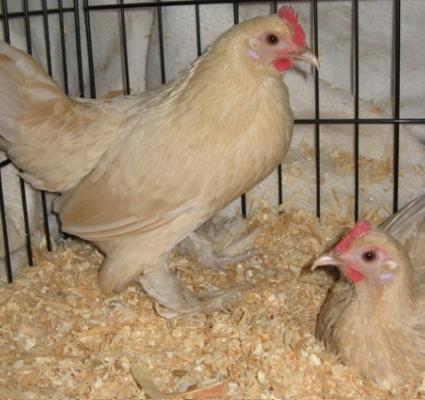
This set of adults was kept by BYC member Pumpkinpup, also down in Georgia. Some of her birds were from Karl Urshel stock.
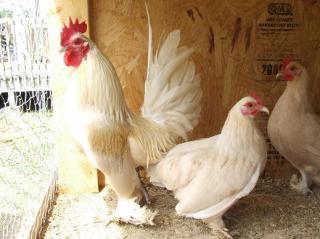
--------------------------------------------------------------------------------------------------
In 2009 I hatched a set of chicks from the above adults. Below are photos of the chicks.
Hatch success rates were strongly related to hen age; I only had around a 10% hatch rate with eggs from first-year hens paired with an older rooster, but a 75% hatch rate with the batch from second-year hens paired with a young cockerel.
At hatch, around 1/2 of the chicks were slightly "lavender" or lav striped in color, and the rest were pure yellow. As you will see, the hatch color translated into the adult colors of either proper butterscotch or a washed-out lavender color. Some of the lavender culls had "dirty" speckling on the wing feathers as they approached maturity, with the speckling sometimes extending up into the lower hackle or tail feathers. The butterscotch color is very much a work in progress!
Those working on this color may wish to color-cull all non-yellow chicks at hatch (or at least by the end of Week 1), since none of the striped or darker-hatching chicks lightened to proper butterscotch as they aged. Then you can watch the remaining yellow chicks to see how their colors fare.
2009 Butterscotch Booted Bantam chicks at 1 week
Here are some of the chicks gathered for their first photo session. As you can see, around 1/2 of the chicks came out clear butterscotch, and the rest ranged from lav striped to partial lav.
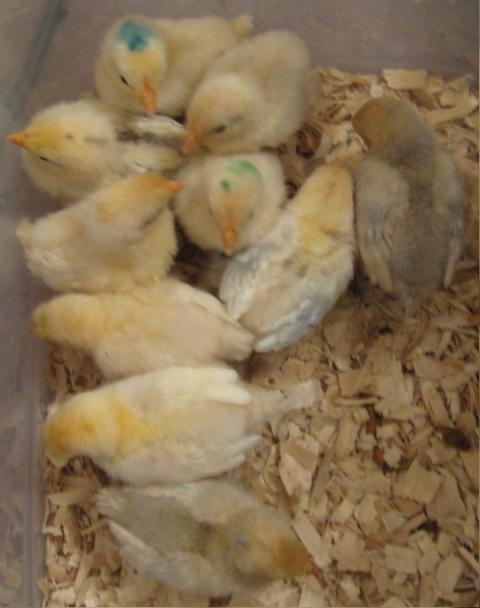
A striped chick:
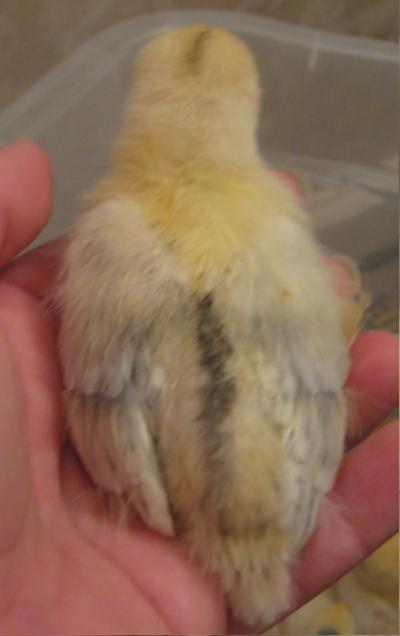
A partial lavender chick:
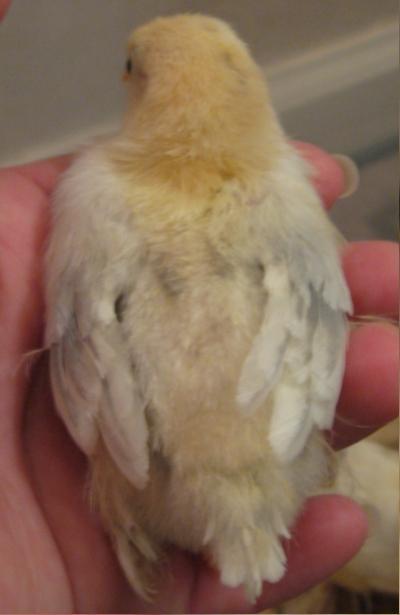
And a pretty clear butterscotch chick:
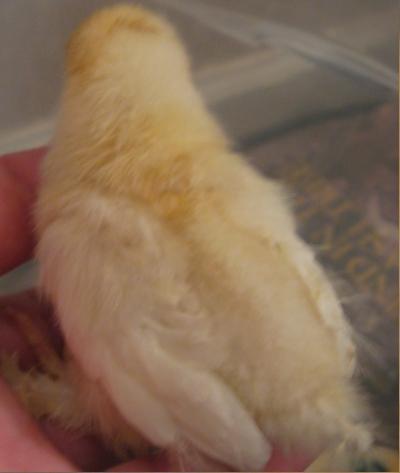
------------------------------------------------------------------------------
2009 Butterscotch Booted Bantam chicks at around 4 weeks
These are the same chicks at 4 weeks of age.
The colors in this photo are not great, but this cockerel had pretty good, clear butterscotch coloring and developed into a nicely-colored adult, as we will see in later pics.
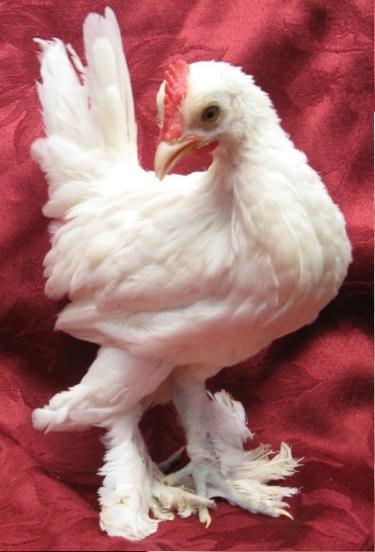
Pretty good butterscotch pullet - -
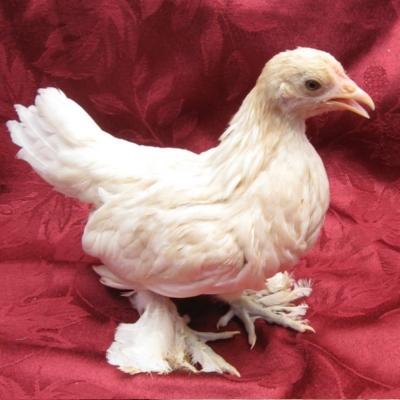
Cull pair - - good body coloring, lavender/porcelain color in tail and dark band at base of beak. Well matched pair, though!
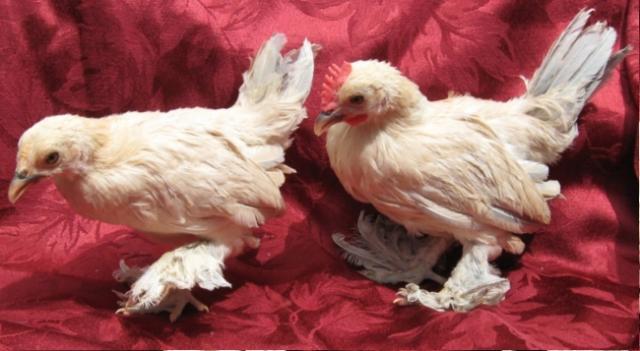
Cull pair of pullets showing the lavender shade. I still have one of these girls in 2011, and she is now a "lemon lavender" color, as we will see in later pics. ("Cull" in my pens does not mean what it often does with big-time breeders. It just means no hatching eggs.)
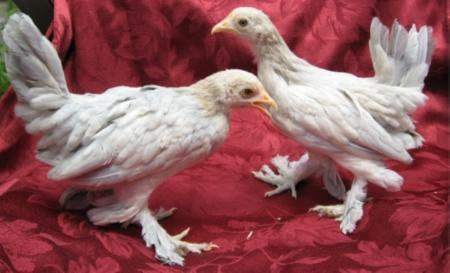
----------------------------------------------------------------------------------------------------------
Below is another pic of one of the "lemon lavender" cull pullets, somewhere between 12-14 weeks.
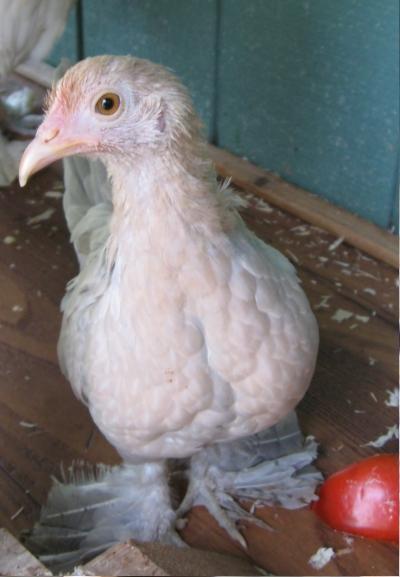
And a photo of the butterscotch cockerel from above, also between 12-14 weeks:
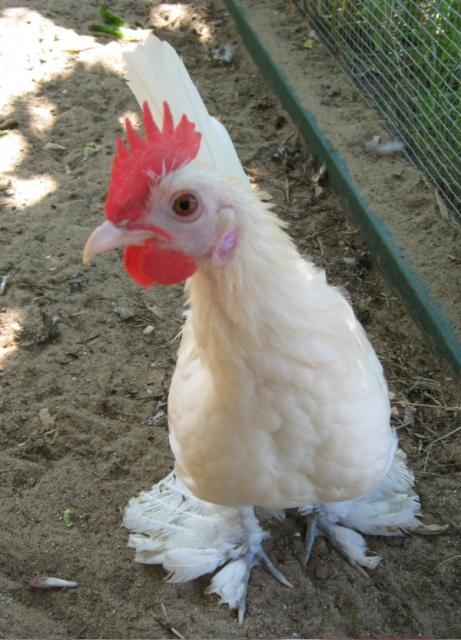
Here is a good comparison photo of the same two birds standing together:
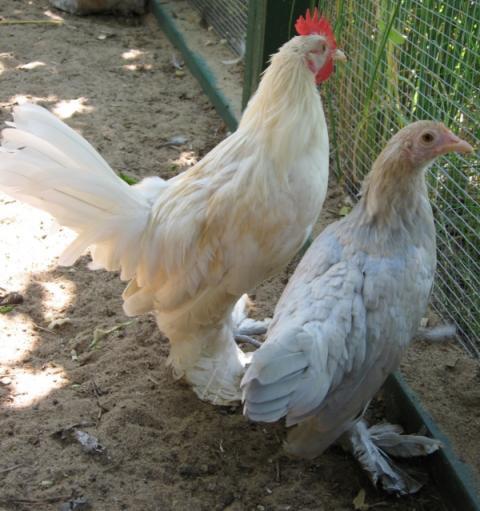
More adult photos coming soon!
